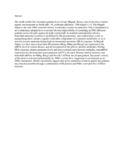Rh Proteins and NH4+ –activated Na+-ATPase in the Magadi Tilapia (Alcolapia grahami), a 100% Ureotelic Teleost Fish.

View/
Date
2013Author
Ojoo, Rodi O
Papah, Michael B
Kavembe, Geraldine D
Bianchini, Lucas F
Johannsson, Ora E
Maina, John N
Bianchini, Adalto
Bergman, Harold L
Chevalier, Claudine
Laurent, Pierre
Wilson, Jonathan M
Nawata, C Michele
Wood, Chris M
Language
enMetadata
Show full item recordAbstract
The small cichlid fish Alcolapia grahami lives in Lake Magadi, Kenya, one of the most extreme aquatic environments on Earth (pH ~10, carbonate alkalinity ~300 mequiv l−1). The Magadi tilapia is the only 100% ureotelic teleost; it normally excretes no ammonia. This is interpreted as an evolutionary adaptation to overcome the near impossibility of sustaining an NH3 diffusion gradient across the gills against the high external pH. In standard ammoniotelic teleosts, branchial ammonia excretion is facilitated by Rh glycoproteins, and cortisol plays a role in upregulating these carriers, together with other components of a transport metabolon, so as to actively excrete ammonia during high environmental ammonia (HEA) exposure. In Magadi tilapia, we show that at least three Rh proteins (Rhag, Rhbg and Rhcg2) are expressed at the mRNA level in various tissues, and are recognized in the gills by specific antibodies. During HEA exposure, plasma ammonia levels and urea excretion rates increase markedly, and mRNA expression for the branchial urea transporter mtUT is elevated. Plasma cortisol increases and branchial mRNAs for Rhbg, Rhcg2 and Na+,K+-ATPase are all upregulated. Enzymatic activity of the latter is activated preferentially by NH4+ (versus K+), suggesting it can function as an NH4+-transporter. Model calculations suggest that active ammonia excretion against the gradient may become possible through a combination of Rh protein and NH4+-activated Na+-ATPase function.
